Index relies entirely on the support of donors and readers to do its work.
Help us keep amplifying censored voices today.
[vc_row][vc_column][vc_column_text]
Index on Censorship, Pen International and Artists at Risk Connection of Pen America stand in solidarity with independent Cuban artists as the 13th Havana Biennial, which begins in the Cuban capital on 12 April and ends 12 May 2019.
The month-long, state-sponsored biennial will showcase the work of international and Cuban artists who are officially-recognised by the Cuban Ministry of Culture.
We, the undersigned organisations, call on the participating artists to support the campaign against the country’s Decree 349. Building upon existing laws and regulations that apply to artists officially recognised by the Cuban government, Decree 349 formalises and widens the scope of artistic censorship in Cuba and creates a new category of art inspectors with the power to unilaterally impose fines, cancel events, and subject artists to asset forfeiture as a penalty for presenting work without authorisation from the state.
Independent artists who have peacefully protested the decree have faced persistent harassment, including repeated arbitrary detentions. Artist Luis Manuel Otero Alcantara was detained last week and again this week. Coco Fusco was denied entry into the country while a family member of artist Tania Bruguera has been harassed. Meanwhile, rappers “Maykel” Castillo Pérez and Lázaro Leonardo Rodríguez Betancourt “Pupito en Sy” have been held in Valle Grande prison since their arrests in September and November 2018, respectively. Arrested shortly after their participation in a public concert critical of Decree 349, the wider Cuban artistic community believes that the charges laid against them have been fabricated in retaliation for their peaceful protest.
Campaigning artists have asked Biennial participants to express solidarity in any way they feel most comfortable with. Suggestions include inviting independent artists affected by Decree 349 to take part in presentations at the Havana Biennial, or supporting alternative events under the title of “Bienal sin 349”. Other actions showing solidarity for participants can include wearing a “No to Decree 349” t-shirts while in Cuba, or even visiting home studios to learn more about the efforts of independent artists. Independent artists only ask that participants find ways to include them in their experience of the Havana Biennial, as they continue to be marginalised and silenced despite government statements that the decree is part of an inclusive and supportive national cultural policy.
The undersigned organisations call on the Cuban authorities to comply with its international obligations as a signatory to the International Covenant on Civil and Political Rights to ensure that independent artists be given the opportunity to peacefully protest during the Biennial without the fear of arrest or harm. We also call for the release of rappers Maykel and Pupito en Sy, and for the charges to be dropped, if as is suspected, they are being targeted for the peaceful exercise of their right to free expression.
Index on Censorship
Pen International
Pen America – Artists at Risk Connection
Tate Modern
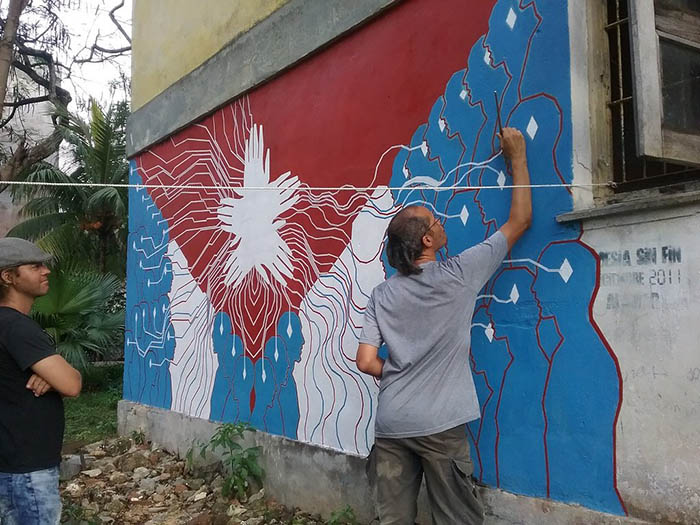
Cuban artist Yasser Castellanos at the 2018 Biennial
We are members of the artist community in Cuba. We are contacting you with the understanding that you have been invited to participate in the 2019 Havana Biennial. As you may know, over the past eight months, a movement has emerged among artists from all disciplines to protest a new law that recently came into effect, known as Decree 349. This law criminalises independent artistic activity and gives art inspectors the right to impose a fine or subject artists to asset forfeiture as a penalty for presenting work without authorisation from the state. The Cuban government created the law without consulting its arts community. We are attaching information about the decree for your review. Please feel free to ask us if you have any questions.
We have been protesting this law through various tactics: some of us have met with government officials to express our opposition to the laws, while others have developed a campaign in social media to foment critical debate about the laws. Many of us have engaged in direct action and have been detained by the Cuban police for attempting to stage a sit-in at the Ministry of Culture in the days leading up to the law going into effect last December. It goes without saying that the government has not been pleased about our protests and has gone to great lengths to characterise us in the Cuban media as counter-revolutionaries and troublemakers who are not worthy of recognition as artists. Nonetheless, it is the first time in almost 60 years that artists from all disciplines, ages and political views have united against a government decree. More than 300 Cuban artists have signed a letter of protest directed to the Ministry of Culture and numerous foreign arts professionals have expressed their solidarity with our cause.
We have not succeeded in getting the government to rescind the law, but officials did announce last December that they would not put the law into effect fully until a set of regulations that are to be discussed with the arts community are finalised. We have not received any further information about those regulations as yet.
We are writing to you to ask for your solidarity and support at a challenging time for Cuban artists. A small gesture of solidarity goes very far in Cuba, particularly in the arts. We are sharing with you a list of artists who are vulnerable due to their protest of Decree 349. We ask you to consider expressing your solidarity in the way you feel most comfortable. We have envisioned several scenarios: You can invite one of the artists affected by the Decree 349 to work with you during your presentation at the Havana Biennial, or you can share part of your exhibition space or stage if you are participating in a public event. You can wear “No to Decree 349” t-shirts while in Cuba to show support for our cause. You can visit us at our home studios to learn more about our efforts. All that we ask is that you find ways to include the artists who are going to be marginalised due to the decree in your experience of the biennial.
As members of a global artistic community, we are all interconnected. Cuban artists have shown their support of other artists in the world when ethically dubious things happen to them. Now we ask for artists to be in solidarity with us, to make Cuba a place in which all cultural expression can thrive.
To contact us please write to: [email protected]
Sincerely,
Lester Alvarez
Italo Expósito
Tania Bruguera
Luis Manuel Otero Alcántara
Yanelys Nuñez Leyva
Amaury Pacheco
Iris Ruiz
Sandor Pérez
Michel Matos
Hamlet Lavastida
Nonardo Perea
Yasser Castellanos
Verónica Vega
Aminta D´Cárdenas
Yoandri Kindelán Sierra
Javier Moreno
René Rodríguez
José Ernesto Alonso
Andrés Pérez
Ariel Maceo Tellez
Abu Duyanah Tamayo
Alejandro Barreras
Francis Sanchez
For more information on Decree 349:
Summary in English: https://frieze.com/article/looking-back-year-art-and-protest-cuba
Artist at Risk Connection white paper Art Under Pressure in English and Spanish[/vc_column_text][/vc_column][/vc_row][vc_row][vc_column][vc_basic_grid post_type=”post” max_items=”4″ element_width=”6″ grid_id=”vc_gid:1556718415064-1beae721-d7d0-2″ taxonomies=”7874″][/vc_column][/vc_row]
[vc_row][vc_column][vc_column_text]
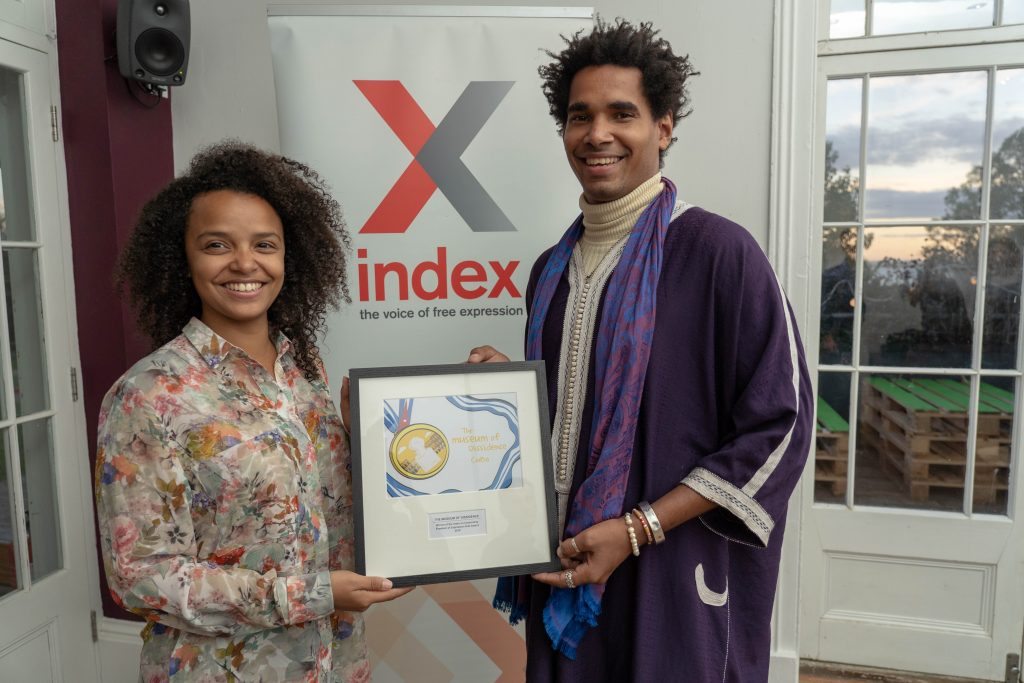
Yanelys Nuñez Leyva and Luis Manuel Otero Alcántara. The Museum of Dissidence
2018 Freedom of Expression Awards at Metal, Chalkwell Park, Essex.
Artistic freedom is under attack in Cuba, but artists are fighting back. Yanelys Nuñez Leyva and Luis Manuel Otero Alcántara, members of the 2018 Index on Censorship Freedom of Expression Award-winning Cuban artist collective the Museum of Dissidence, along with many others, are putting themselves on the line in the fight against Decree 349, a vague law intended to severely limit artistic freedom in the country. Decree 349 will see all artists — including collectives, musicians and performers — prohibited from operating in public places without prior approval from the Ministry of Culture.
“349 is the image of censorship and repression of Cuban art and culture, and is also an example of the exercise of state control over its citizens,” Otero Alcántara tells Index. “Artists, in a spectacular way, must work in a state of double resistance, as artists and as activists, because the system has control over all opportunities for artistic growth.”
For their role in peacefully protesting Decree 349, Otero Alcantara and Nuñez Leyva were among 13 artists arrested, including Cuban performance artist Tania Bruguera, in Havana on 3 December 2018. Index joined others at the Tate Modern in London on 5 December in a show of solidarity with those jailed.
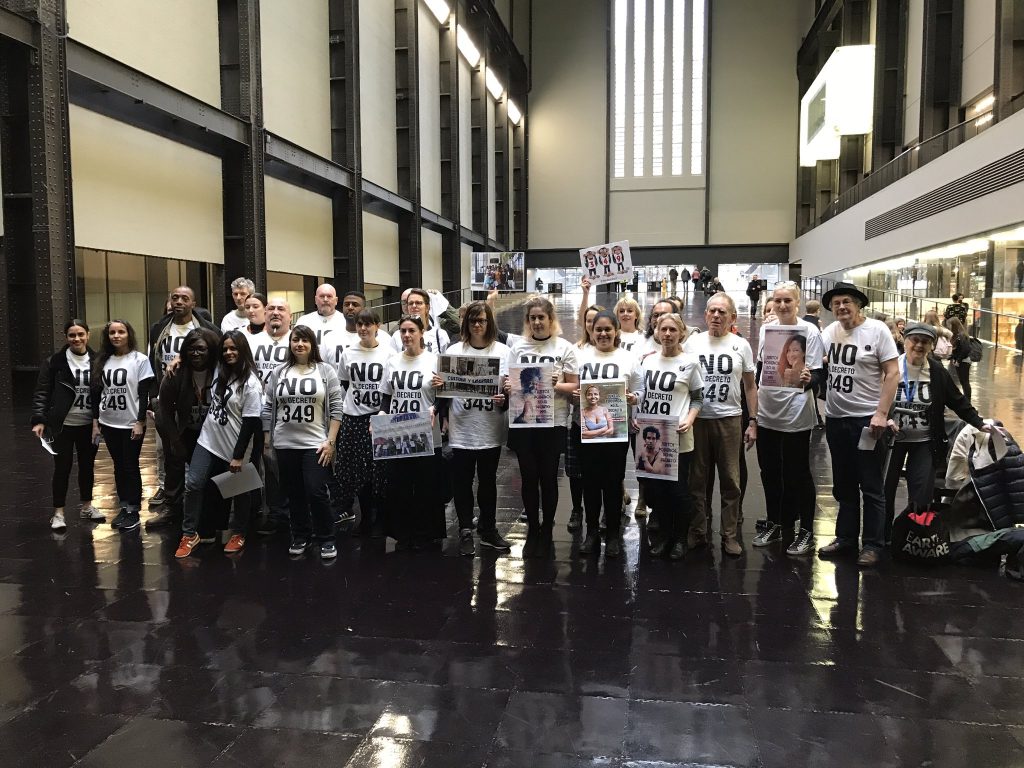
Protest in support of jailed Cuban artists at the Tate Modern gallery, London, October 2018.
On Human Rights Day on 10 December 2017, US Assistant Secretary of State Kimberly Breier tweeted: “[O]ur minds turn to the people of #Cuba, who have endured decades of repression and abuse at the regime’s hands, most recently via the creativity-crushing #Decree349.”
“The international help is positive because it makes visible the abuses of the Cuban regime against the people, but I think we must sacrifice ourselves in body and spirit — in a peaceful way — if we want to achieve our freedom,” Nuñez Leyva tells Index on Censorship. “We are very grateful for any help and pronouncements against 349. The redaction of the decree and the silence of the authorities is demonstrating that in Cuba there is a dictatorial regime in which no type of political, economic or social opening is taking place.”
In the days following all arrested artists were released, although they remained under police surveillance. Cuba’s vice minister of culture Fernando Rojas at the time told the Associated Press that changes would be made to Decree 349 but failed to open a dialogue with the artists involved in the campaign against the decree. A version of the law came into force on 7 December.
“We are determined to continue demanding the full repeal of 349,” Nuñez Leyva says. “We do not want to continue living in this perennial state of vulnerability.”
The persecution of the Museum of Dissidence isn’t limited to arrests. On 9 November Otero Alcántara took to Facebook to call out a campaign to discredit him. State security had been sending texts and holding meetings with his neighbours in what the artist said was a “desperate attempt” to “sabotage our activities”.
“The rhetoric that the government uses is well known to all — that we are mercenaries — and although most people no longer believe it, some of them decide to exclude you because you are a ‘marked’ person like you have a contagious disease,” Otero Alcántara tells Index. “You are a socially excluded and politically persecuted.”
“We try all the time not to give it too much importance, we try to smile because we really do not want to feel any bad energy,” he adds. “Our principle is love, dialogue, peaceful struggle. If they wish to defame us, it is on their conscience, not ours.”
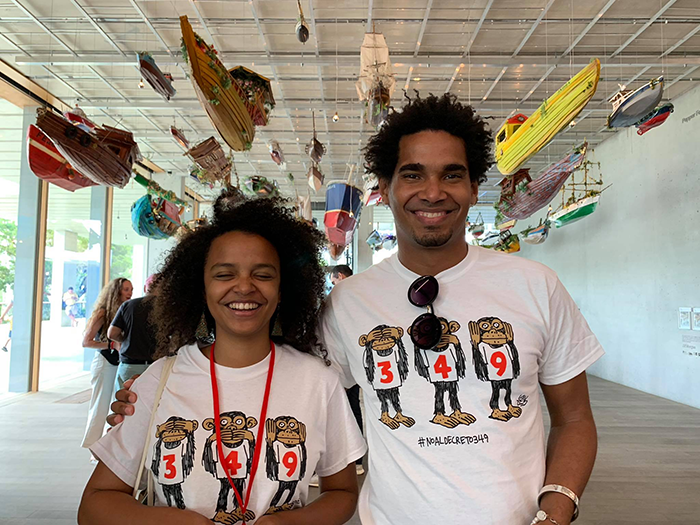
Cuban artists Luis Manuel Otero Alcantara and Yanelys Nuñez Leyva, members of the Index-award winning Museum of Dissidence
Nuñez Leyva describes the efforts to dissuade Cuban artists from protesting 349 — including the seizure of anti-349 t-shirts emblazoned with three wise monkeys when re-entering Cuba after attending the Creative Time Summit in Miami — as “a mechanism to prevent the spread of the truth and above all, to make us tired and to resort to leaving the country”. But the Museum of Dissidence will not be deterred. “To achieve that, they will have to be more vicious.”
“The government spends innumerable resources to repress any type of expression that makes it uncomfortable,” Otero Alcántara says. “It seeks to discredit activists and artists all the time by isolating them from society, from their friends, from their family.”
After a seven-month campaign to attain visas to enter the UK — which saw the Museum of Dissidence denied visas on three occasions, causing them to them miss the Index on Censorship Freedom of Expression Awards ceremony in April 2018 — Nuñez Leyva and Otero Alcántara were finally able to receive their award at Metal Culture, an arts centre in Chalkwell Hall, Southend-on-Sea, on 18 October 2018. The artists were in residence at Metal for two weeks in October as part of their partnership with Index on Censorship.
“Southend-on-Sea generously gave us all its warmth. Staff at Metal, the uncharacteristically warm climate, the brick architecture of the place, the low tide river, the local legends told by a science fiction writer, the banks that paid homage to the deceased, the interest of the local media in the Cuban cause were encouraging for us,” Nuñez Leyva says. “To realise that a calm, inclusive city is possible opens us up and make us less naive when going back to face the Cuban reality.”

Luis Manuel Otero Alcantara as Miss Bienal
During his time in the UK, Otero Alcántara performed in Trafalgar Square on 26 October as Miss Bienal, a character he created in 2016 to symbolise the mulatto woman typified in clichés by tourist and for artistic consumption.
“Entering the National Gallery in a rumba dress without censorship made us realise the context of freedom and acceptance of difference that is breathed in London,” he says. “London is a giant city with so much art, diversity and history, it makes the body detoxify a bit from the bad energy you get living in a system like the Cuban one.”
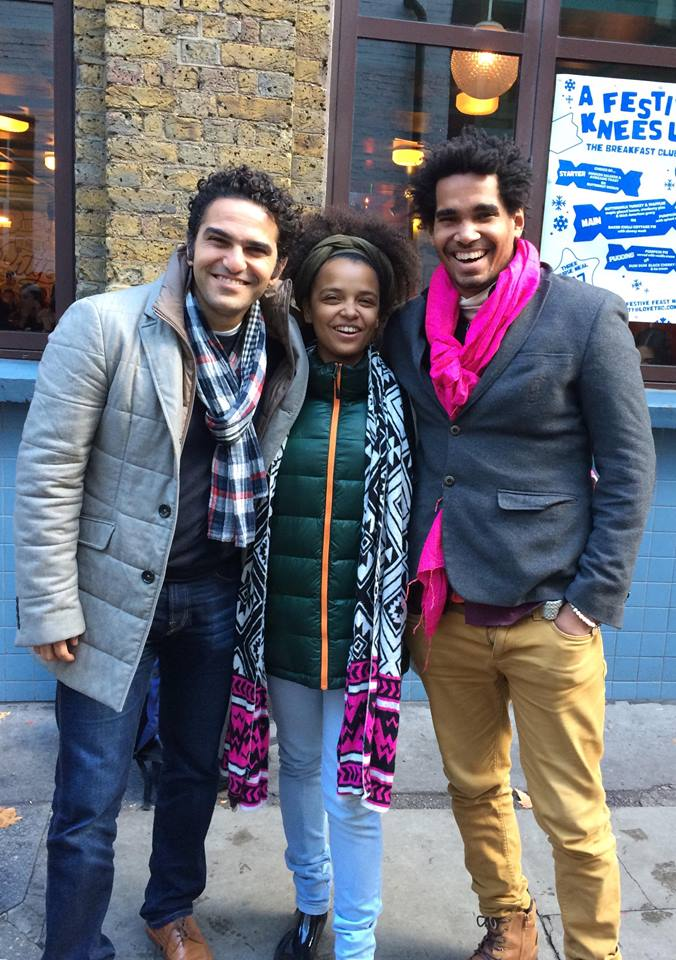
Mohamed Sameh with Yanelys Nuñez Leyva and Luis Manuel Otero Alcantara in London
While in London, the pair met with Mohamed Sameh, co-founder and international relations advisor at the Egyptian Commission for Rights and Freedoms, winner of the 2018 Index on Censorship Freedom of Expression Award for Campaigning. ECRF is one of the few remaining human rights organisations in Egypt, a country that often uses its struggle against terrorism as a justification for its crackdown on human rights.
“We shared with Mohamed the desire for prosperity in our respective countries, but also the smile that we shared, which we hold on to all the time,” Nuñez Leyva says. “The contagious smile of Mohamed is similar to that of, not only of the Museum of Dissidence in Cuba, but also Amaury Pacheco, Iris Ruiz, Coco Fusco, Student without Seed, Michel Matos, Aminta D’Cardenas, La Alianza, Yasser Castellanos, Veronica Vega, Javier Moreno, Tania Bruguera, and other artists who at this moment are fully engaged in the improvement of Cuba.”
“Although our contexts are different, we feel a total empathy with the struggles of Mohamed, because in our work we put ourselves at risk all the time for our rights and total freedom of expression, principles that for Mohamed are also non-negotiable.” [/vc_column_text][/vc_column][/vc_row][vc_row][vc_column][vc_basic_grid post_type=”post” max_items=”4″ element_width=”6″ grid_id=”vc_gid:1547483905239-0a56285c-5eb0-10″ taxonomies=”23707″][/vc_column][/vc_row]
[vc_row][vc_column][vc_column_text]
Bruguera who was due to attend Kochi states in the letter:
“At this moment I do not feel comfortable traveling to participate in an international art event when the future of the arts and artists in Cuba is at risk… As an artist I feel my duty today is not to exhibit my work at an international exhibition and further my personal artistic career but to expose the vulnerability of Cuban artists today.”
Bruguera feels it is important to highlight the situation in Cuba and also to see it as part of a global phenomenon of repression of artists and freedom of expression. Recent cases such as Shahidul Alam, the photographer imprisoned by the government of Bangladesh (who Bruguera campaigned for by hosting two protest shows at Tate Modern in October), the Saudi journalist Jamal Khashoggi killed in the Saudi embassy in Turkey, and photographer Lu Guang who has gone missing in China, demonstrate that governments feel emboldened to openly attack high profile figures, moving beyond internal state repression which used to happen behind closed doors.
On Wednesday 5 December supporters of Bruguera held a protest exhibition at Tate Modern’s Turbine Hall, where participants spoke on a microphone about Decree 349 and the abuse of artists around the world. Alistair Hudson, director of the Whitworth and Manchester Art Gallery spoke at the event via live phone in. Tate director Maria Balshaw, also spoke out on the BBC news broadcast of the Turner Prize whilst Tate Modern director Frances Morris made a statement on Tate twitter. A speech by HRH Prince Constantijn on the occasion of the 2018 Prince Claus Awards at the Royal Palace, Amsterdam on 6 December 2018 also spoke about the situation with reference to Tania Bruguera, Shahidul Alam and Lu Guang. Many other cultural institutions around the world have also made public statements, whilst others are showing signs that they will follow.
The hope is that art institutions and events around the world, such as Kochi biennial, follow suit and show open solidarity to defend the artists’ space.
The full wording of Bruguera’s letter is as follows:
OPEN LETTER BY TANIA BRUGUERA TO THE DIRECTOR OF KOCHI BIENNALE ON DECREE 349
At this moment I do not feel comfortable traveling to participate in an international art event when the future of the arts and artists in Cuba is at risk. The Cuban government with Decree 349 is legalizing censorship, saying that art must be created to suit their ethic and cultural values (which are not actually defined). The government is creating a `cultural police´ in the figure of the inspectors, turning what was until now, subjective and debatable into crime.
Cuban artists have united for the first time in many decades to be heard, each with their own points of view. They had meetings with bureaucrats from the Ministry of Culture who promised them that they would meet again to give them answers. Instead, the Minister and other bureaucrats appeared on TV and made comments such as “[those who oppose Decree 349] want the dissolution of the institution” and “the alternative they are proposing is the commercialisation of art.”
Nothing could be further from the truth. If this were true, the artists would not have written to the institutions and sought dialogue with them.
But, a public opinion campaign by the government against the artists, with the intention to divide between “good ones” and “bad ones”, has started. This is even more concerning when under this decree the law restricts but provides no guarantee of whether an artist will or will not be criminalized or not at any time.. Moreover, the decree states that all `artistic services´ must be authorized by the Ministry of Culture and its correspondent institutions, making independent art impossible.
The last time a decree of this sort was enacted was the no. 226 from November 29 of 1997, which is evidence of the long life that such a decree could have and its long term impact on our culture.
As an artist I feel my duty today is not to exhibit my work at an international exhibition and further my personal artistic career but to be with my fellow Cuban artists and to expose the vulnerability of Cuban artists today.
We are all waiting for the regulations and norms the Ministry of Culture will put forward to implement Decree 349 in the hope that they include the suggestions and demands so many artists shared with them. I would like to add that the instructor from the Ministry of Interior who is in charge of my case menaced me yesterday, saying that if I didn’t leave Cuba and if I did `something´, I would not be able to leave in the future.
Injustice exists because previous injustices were not challenged.
Ironically, I’m sending you this text on December 10th the International Day of Human Rights.
Un abrazo,
Tania Bruguera[/vc_column_text][/vc_column][/vc_row][vc_row][vc_column][vc_basic_grid post_type=”post” max_items=”4″ element_width=”6″ grid_id=”vc_gid:1544431942749-6dbcba3e-bd36-2″ taxonomies=”15469, 7874″][/vc_column][/vc_row]
[vc_row][vc_column][vc_column_text]
Update: All arrested artists have now been released, although they remain under police surveillance. Cuba’s vice minister of culture Fernando Rojas has declared to the Associated Press that changes will be made to Decree 349 but has not opened dialogue with the artists involved in the campaign against the decree.
Index on Censorship joined others at the Tate Modern on 5 December in a show of solidarity with those artists arrested in Cuba for peacefully protesting Decree 349, a law that will severely limit artistic freedom in the country. Decree 349 will see all artists — including collectives, musicians and performers — prohibited from operating in public places without prior approval from the Ministry of Culture.
In all, 13 artists were arrested over 48 hours. Luis Manuel Otero Alcantara and Yanelys Nuñez Leyva, members of the Index on Censorship Freedom of Expression Award-winning Museum of Dissidence, were arrested in Havana on 3 December. They are being held at Vivac prison on the outskirts of Havana. The Cuban performance artist Tania Bruguera, who was in residency at the Tate Modern in October 2018, was arrested separately, released and re-arrested. Of all those arrested, only Otero Alcantara, Nuñez Leyva and Bruguera remain in custody.
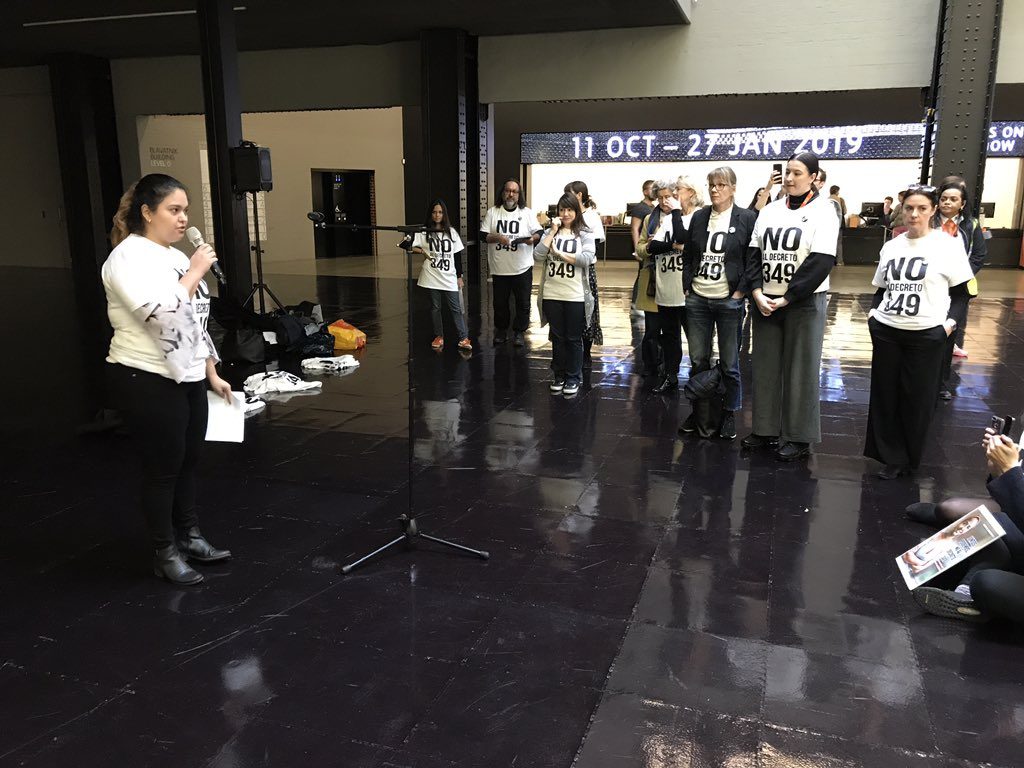
Index on Censorship’s Perla Hinojosa speaking at the Tate Modern.
Speaking at the Tate Modern, Index on Censorship’s fellowships and advocacy officer Perla Hinojosa, who has had the pleasure of working with Otero Alcantara and Nuñez Leyva, said: “We call on the Cuban government to let them know that we are watching them, we’re holding them accountable, and they must release artists who are in prison at this time and that they must drop Decree 349. Freedom of expression should not be criminalised. Art should not be criminalised. In the words of Luis Manuel, who emailed me on Sunday just before he went to prison: ‘349 is the image of censorship and repression of Cuban art and culture, and an example of the exercise of state control over its citizens’.”
Other speakers included Achim Borchardt-Hume, director of exhibitions at Tate, Jota Castro, a Dublin-based Franco-Peruvian artist, Sofia Karim, a Lonon-based architect and niece of the jailed Bangladeshi photojournalist Shahidul Alam, Alistair Hudson, director of Manchester Art Gallery and The Whitworth, and Colette Bailey, Artistic director and chief executive of Metal, the Southend-on-Sea-based arts charity.
Some read from a joint statement: “We are here in London, able to speak freely without fear. We must not take that for granted.”
It continued: “Following the recent detention of Bangladeshi photographer Shahidul Alam along with the recent murder of journalist Jamal Khashoggi, there us a global acceleration of censorship and repression of artists, journalists and academics. During these intrinsically linked turbulent times, we must join together to defend our right to debate, communicate and support one another.”
Castro read in Spanish from an open declaration for all artists campaigning against the Decree 349. It stated: “Art as a utilitarian artefact not only contravenes the Universal Declaration of Human Rights (Cuba is an active member of the United Nations Organisation), but also the basic principles of the United Nations for Education, Science and Culture (UNESCO).”
It continued: “Freedom of creation, a basic human expression, is becoming a “problematic” issue for many governments in the world. A degradation of fundamental rights is evident not only in the unfair detention of internationally recognised creatives, but mainly in attacking the fundamental rights of every single creator. Their strategy, based on the construction of a legal framework, constrains basic fundamental human rights that are inalienable such as freedom of speech. This problem occurs today on a global scale and should concern us all.”

Cuban artists Luis Manuel Otero Alcantara and Yanelys Nuñez Leyva, members of the Index-award winning Museum of Dissidence
Mohamed Sameh, from the Index on Censorship Freedom of Expression Award-winning Egypt Commission on Rights and Freedoms, offered these words of solidarity: “We are shocked to know of Yanelys and Luis Manuels’s detention. Is this the best Cuba can do to these wonderful artists? What happened to Cuba that once stood together with Nelson Mandela? We call on and ask the Cuban authorities to release Yanelys and Luis Manuel immediately. The Cuban authorities shall be held responsible of any harm that may happen to them during this shameful detention.”[/vc_column_text][/vc_column][/vc_row][vc_row][vc_column][vc_basic_grid post_type=”post” max_items=”4″ element_width=”6″ grid_id=”vc_gid:1544112913087-f4e25fac-3439-10″ taxonomies=”23772″][/vc_column][/vc_row]